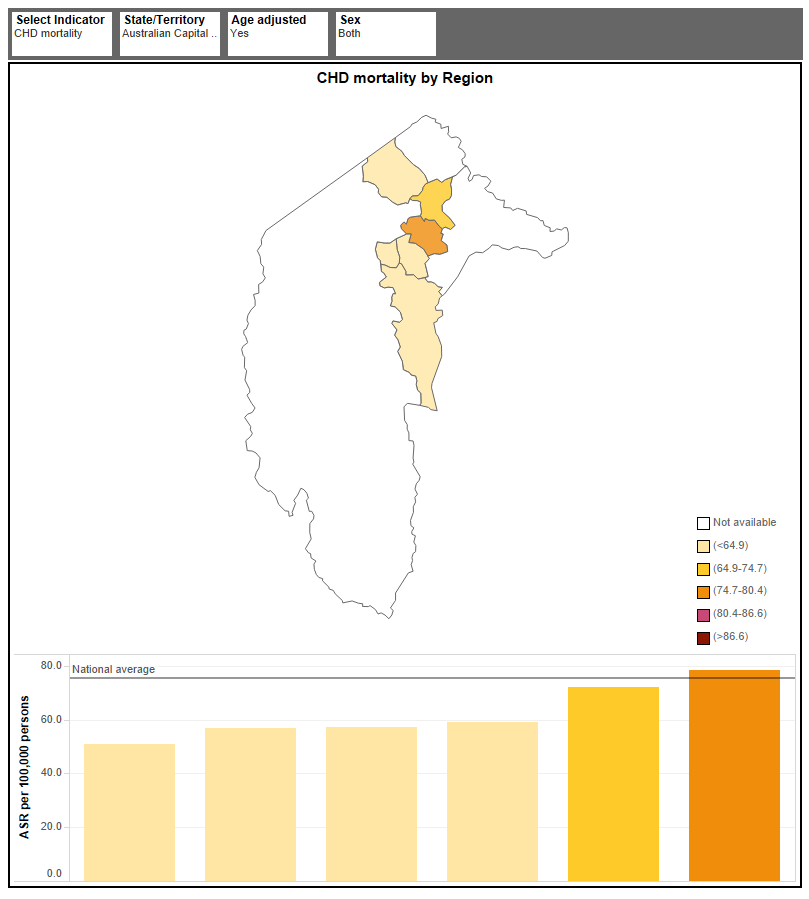
Belconnen residents have the highest heart-related medical incidents in Canberra while Woden and Weston Creek residents have the lowest, according to new figures from the Heart Foundation.
The data is from a national research piece, Heart Maps, which measures hospital admissions, mortality and risk factor statistics across Australia.
Heart Maps allows the Heart Foundation to analyse rates of heart attacks in distinct ACT regions. In the ACT, heart-related hospital admission rates are highest in the Belconnen region (51.0, Age Standardised Rate) followed by South Canberra (46.8, ASR) with rates being the lowest in the Woden and Weston Creek region at 35.5, ASR per 10,000 people.
Belconnen has the highest heart attack (18.6, ASR) and unstable angina (12.4, ASR) hospital admission rates and second highest heart failure (19.8, ASR) admission rates, with South Canberra having the highest heart failure admission rates at 22.0, ASR.
Rates of death due to heart disease are considerably higher in South Canberra and North Canberra (78.4, ASR and 72.3, ASR respectively) compared with all other ACT regions – Tuggeranong (59.2), Weston Creek (57.3), Belconnen (56.9) and Woden (50.9).
ACT ranks third highest for heart related admissions (ASR) but this will, in part, be due to cross border separations. It has the lowest age-adjusted rate of CHD mortality,
the second lowest obesity prevalence and the lowest smoking rates.
Men are two times more likely as women in the ACT to be admitted for a heart condition (2.07), or to die from coronary heart disease (1.98). For ST-Elevation Myocardial Infarction (STEMI), men are more than three times as likely to be hospitalised (3.42). However, risk factors are more evenly distributed across the genders; with men and women equally likely to
be obese (0.92) or to be a current smoker (0.99).
South Canberra has the highest coronary heart disease death rate (both age-adjusted and unadjusted). The unadjusted rate for South Canberra (123.2 per 100,000 people) is
three times higher than Tuggeranong (40.2 per 100,000 people).
The research also shows that people who live in disadvantaged, or rural and remote areas have poorer heart health.
CEO of the ACT Heart Foundation, Tony Stubbs said it was not about who was the ‘unhealthiest’ or the ‘fittest’.
“It’s about how we can better focus health services and resources,” he said.
“It’s about being smarter – and better informed.”

He said the Heart Foundation was working to ensure health services in the ACT not only met the health needs of all Canberrans, but were available to those that needed them most.
He said Heart Maps would provide valuable insights to help inform the Territory-Wide Health Services Framework and Preventative Health Strategy.
“I’m quietly confident we are working towards a future where health services are offered around a person’s needs. As opposed to where a person navigates old or clunky systems. That might have been sufficient 40 years ago, but not today,” he said.
“This is what being ‘integrated and coordinated’ means. I’m pleased to see the Government headed down a reform path, with new clinical centres, and specialty services plans that will address specific health conditions.”
Mr Stubbs encouraged people to take an active interest in managing their heart risk factors.
“Check you don’t have high cholesterol or high blood pressure. Keep your salt intake below one teaspoon a day. Don’t smoke. Move more, eat healthily,” he said.
“Know the signs of a heart attack and act on them immediately.”
Mr Stubbs said it was critical that anyone who has had a heart attack went to a cardiac rehabilitation program.
“These programs save lives by helping prevent a second heart event,” he said.
The Heart Maps, background information and a full technical report describing the data and analysis are available on the Heart Foundation website https://www.heartfoundation.org.au/for-professionals/heart-maps/australian-heart-maps












